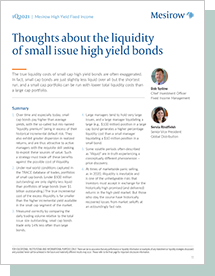Insights
Thoughts about the liquidity of small issue high yield bonds
Share this article
The true liquidity costs of small cap high yield bonds are often exaggerated. In fact, small cap bonds are just slightly less liquid over all but the shortest run, and a small cap portfolio can be run with lower total liquidity costs than a large cap portfolio.
Summary
- Over time and especially today, small cap bonds pay higher than average yields, with the so-called but mis-named “liquidity premium” being in excess of their historical incremental default risk. They also exhibit greater dispersion in realized returns, and are thus attractive to active managers with the requisite skill seeking to exploit these sources of value. Such a strategy must trade off these benefits against the possible cost of illiquidity.
- Under real world conditions captured in the TRACE database of trades, portfolios of small cap bonds (under $500 million outstanding) are only slightly less liquid than portfolios of large bonds (over $1 billion outstanding.) The true incremental cost of the excess illiquidity is far smaller than the higher incremental yield available in the small cap segment of the market.
- Measured correctly by comparing the daily trading volume relative to the total issue size outstanding, small cap bonds trade only 14% less often than large bonds.
- Large managers tend to hold very large issues, and a large manager liquidating a large (e.g., $100 million) position in a large cap bond generates a higher percentage liquidity cost than a small manager liquidating a $10 million position in a small bond.
- Some volatile periods often described as “illiquid” are in truth experiencing a conceptually different phenomenon – price discovery.
- At times of marketwide panic selling, as in 2020, illiquidity is inevitable and is one of the unhedgeable risks that investors must accept in exchange for the historically high promised (and delivered) returns in the high yield market. But those who stay the course have historically recovered losses from market selloffs at an astoundingly fast rate.

FOR EDUCATIONAL, INSTITUTIONAL AND INFORMATIONAL PURPOSES ONLY. There can be no assurance that any performance or liquidity information or examples of any investment or liquidity strategies discussed and provided herein will be achieved in the future and materially different results may occur. Please refer to the final page for important disclosure information.
Spark
Our quarterly email featuring insights on markets, sectors and investing in what matters
